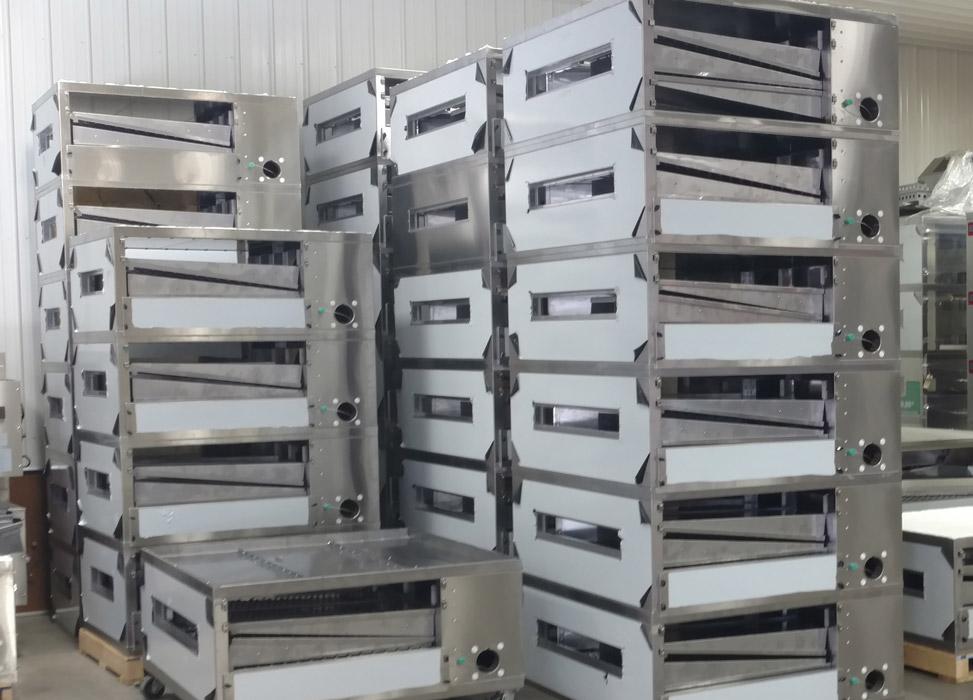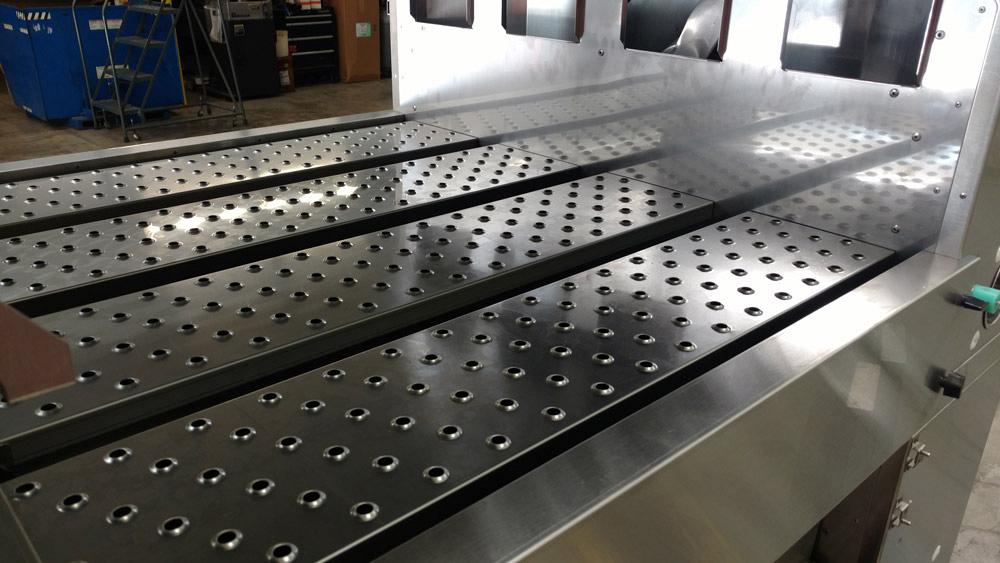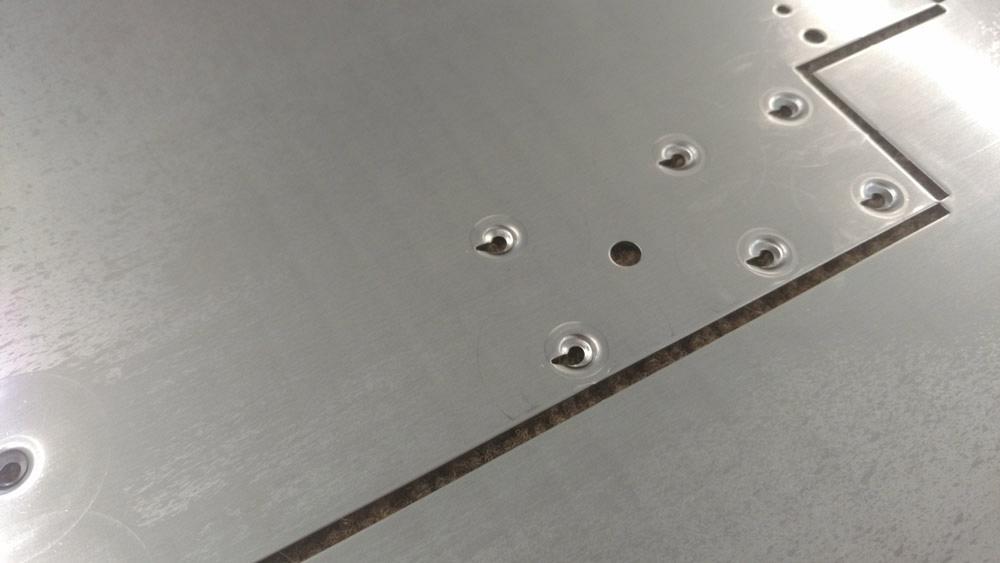Senior Editor
- FMA
- The Fabricator
- FABTECH
- Canadian Metalworking
Categories
- Additive Manufacturing
- Aluminum Welding
- Arc Welding
- Assembly and Joining
- Automation and Robotics
- Bending and Forming
- Consumables
- Cutting and Weld Prep
- Electric Vehicles
- En Español
- Finishing
- Hydroforming
- Laser Cutting
- Laser Welding
- Machining
- Manufacturing Software
- Materials Handling
- Metals/Materials
- Oxyfuel Cutting
- Plasma Cutting
- Power Tools
- Punching and Other Holemaking
- Roll Forming
- Safety
- Sawing
- Shearing
- Shop Management
- Testing and Measuring
- Tube and Pipe Fabrication
- Tube and Pipe Production
- Waterjet Cutting
Industry Directory
Webcasts
Podcasts
FAB 40
Advertise
Subscribe
Account Login
Search
Flexible metal fabrication, however you slice it
Pizza oven maker punches up quick response
- By Tim Heston
- October 31, 2016
- Article
- Punching and Other Holemaking
About 11 years ago Jeremie Pastorius “fell into a job” (his words) at MF&B Restaurant Systems, a company in the pizza business. It wasn’t a pizza shop, though that’s where both of the company founders got their start, but it made something no pizzeria could do without: ovens.
At least that was the plan 11 years ago. At that point the owners, Mike French and Mark Bielstein, had been rebuilding and repairing ovens for about 10 years. The impetus behind the business was straightforward enough. Owning pizzerias, both Bielstein and French grew tired of ovens breaking and paying someone else to fix them. So they started fixing ovens themselves, and before long their repair shop was booming.
Still, after years of working with and repairing ovens, the two saw flaws in the ovens’ design. They had operated pizzerias. They knew what worked in an oven and what didn’t. They knew what elements in those ovens kept breaking, and they knew what made some ovens difficult to clean and repair. So they asked the obvious question: Why not build ovens ourselves?
About this time Pastorius entered the picture. “We started manufacturing ovens with the end user in mind, considering ease of use, maintenance, and cleaning. Because everybody here basically was an end user at one time.”
Pastorius is now manufacturing manager at the Dunbar, Pa., manufacturer, which makes a configurable product line called Edge Ovens. Over the past decade, Pastorius has found that building a pizza oven, fabricated mostly of magnetic food-grade 430 stainless steel (the “dough,” so to speak), is in some respects a lot like making a pizza. You have standard models (cheese, pepperoni, veggie) as well as custom models (hold the anchovies). You make them all to order, but you have all the ingredients on hand (prefabricated parts, flexible punch tooling) to respond when the customer pulls the trigger for an order.
It’s about rapid response. Of course, the tools Pastorius and his team have used over the years have changed, sometimes dramatically, but the goal of rapid response really hasn’t.
From Scratch
Pastorius wasn’t brought in specifically to ramp up a manufacturing operation, but it turned out that way in the end. “I was basically friends with the owners. I was in between jobs, and I started in the wash bay, cleaning components we needed to rebuild ovens. I really seemed to have a knack for the CNC part of the job. And I’ve grown with the company for 11 years now.”
When Pastorius started, the company employed only five people in the shop. He recalled his early days on the job, putting together some of the very first Edge Ovens. “I used to call myself a one-man band,” he said. “At one time I actually did all the programming, the punching, and the bending myself. Then we got a little busier, so we hired someone else to run the press brakes. Then we got even busier yet, and we got the new punch press, and it evolved from there.”
From the start the company decided to keep most metal fabrication in-house, essentially to ensure quick response. Since the beginning, all manufacturing has remained in the U.S., all in Dunbar, Pa. “Except for consumables, everything is made in-house,” Pastorius said.
Eleven years ago Pastorius really didn’t have that many tools at his disposal. “We started with minimal tooling and a few machines,” he said. “We made do with what we had. We started from some very old equipment, and then progressed from there.”

Figure 2
Base oven components are put in inventory, then pulled and configured once a customer triggers an order.
Today the head count remains small, at only 15 people, but the operation has matured significantly—essentially from one or two people pushing parts through the shop to a highly flexible operation. After punching, some parts flow to one of the company’s two 150-ton, 10-ft. press brakes. The company also does its own gas tungsten arc welding, grinding and polishing, electrical wiring, assembling, testing, and packaging. Before any oven leaves the shop, each is run at least two hours. The company then preps the package for shipment, and sometimes even delivers and installs the unit at the customer’s facility.
MF&B now makes seven different base models that range from a 30-in.-wide to a 60-in.-wide bake chamber, and Pastorius tries to keep 20 of each base model in the warehouse. In all models, aside from a few ¼-in. round rods, everything is made of stainless steel sheet.
The company also builds ovens to custom sizes on occasion—such as, say, when a restaurant wants an oven a few inches taller or shorter than standard. In this case, the oven enclosure components are fabricated from scratch. And some customers may want certain parts altered, like a certain radius edge to a particular panel, which can be nibbled on a punch press.
But for the most part, ovens are configured to order, meaning that the manufacturer builds a basic oven and puts it in inventory. Once a customer triggers an order, the shop pulls the base oven from the warehouse and configures it for the customer. After an order is posted, the final assembler pulls the ovens he needs from inventory, stacks them on a base, reads the work instructions from his iPad®, and fills the order as needed, be it for a single-, double-, or triple-stack oven (see Figures 1-3).
Custom components include what are known as “fingers,” which establish the bake pattern on a pizza. These are impinge ovens, which cook with forced hot air, and the fingers—formed sheet metal parts with specific tapers—are designed to guide the direction, volume, and speed of the airflow. This, along with the hole size and pattern that the air flows through, creates a pizza’s bake pattern. Which bake pattern works best depends on the pizza being cooked and the thickness of the dough.
These ovens were designed from the ground up for ease of use and maintenance, and modular components help achieve that goal. This even includes those custom fingers that create the bake pattern. Assemblers can create numerous bake patterns using fewer than 10 finger components. Pastorius said that the shop tries to keep a buffer stock of about 20 of each finger component so that assemblers always have the parts they need to configure an oven to order.
All this makes for a classic pull-type part flow. Assemblers drawing down the stock triggers replenishment orders in the fab shop. Over the years Pastorius has noticed certain demand trends and has scheduled the shop to suit. He also is in charge of nesting and can usually place multiple parts from multiple models on one nest, depending on customer demand at the time.
Still, to keep things simple, he aims for 90 percent or more sheet utilization on the punch presses and avoids having sheet remnants to manage (see Figure 4). This means that he might occasionally program a few extra parts here and there. This adds to the buffer stock in inventory, but because these are standard components for the company’s own product line, he can pretty much guarantee they will be needed soon.
All the same, the company doesn’t want to carry more buffer stock than it needs, so the faster the fab shop can replenish parts, the better. The shop does group like jobs together when it can to reduce the number of setups. But quite often this just isn’t practical, since the shop essentially is producing to customer demand. Such quick response demands two basic elements of modern fabrication: speed and flexibility.
Speed: Fewer Steps, Less Handling
The manufacturer currently has no laser, and the reason becomes obvious when you see parts emerging from the punch presses. The company uses form tools extensively, which helps eliminate the need for downstream operations. Along with standard punches, the shop has a plethora of custom shapes as well as custom forming tools.

Figure 3
Ovens are assembled and tested before being shipped to the customer. Besides offering single ovens, the company builds double-stack and triple-stack configurations as well.
“For instance, we used to bolt our ovens together with [projection welding] nuts,” Pastorius said. “It was just too time-consuming, with an operator standing all day by the spot welder. Now we create a form on the punch press that allows us to put all the ovens together with screws.”
This isn’t a tapping tool, but instead a thread forming tool from Wilson Tool that forms a kind of an embossment surrounding a special hole shape. Plainly visible on a cross-sectional view, the hole edge makes a spiral that forms a thread (see Figure 5).
Using these and other form tools, combined with some slight product design changes, MF&B eliminates entire manufacturing steps. The company also uses a part identification punch tool (Multi-Scribe®) with a tiny center punch that marks the metal with letters and numbers, a little like a dot-matrix printer.
Does identifying parts add to the punching cycle time? Certainly, but as Pastorius explained, part marking also helps keep everything organized and identified. A little extra time on the punch press is a lot better than hours lost looking for and remaking a lost part.
Fast Punch Changeover: About Sharing
Today Pastorius has twice as much tooling as he does stations in his punch presses. But 30 percent of those stations are shared; that is, a universal toolholder in that station can accept a variety of punch tips, using Wilson’s EXP™ punch technology (see Figure 6). So instead of switching out an entire punch assembly, the operator swaps out the tool tip, die, and stripper.
“We’ve gained about 40 percent more space in our storage area, since we just store the tip, the die, and the stripper, rather than the full tool body,” Pastorius said.
He added that to change over to a new tip takes about 40 seconds. He also has extra tips handy so that if one tip needs to be sharpened, the operator can swap out the worn tip with a new one.
About Quick Response
When it comes to quick response in a custom or configurable manufacturing environment, quick changeover matters, but so too does overall process efficiency, from raw stock to order shipment. Fast changeover wouldn’t mean as much without part identification (helping to errorproof assembly) or using form tools extensively.
Put another way, if Pastorius had just concentrated on quick-change tooling, and yet still didn’t consider secondary operations, the bottlenecks wouldn’t have magically gone away. He would have been able to change out tooling in seconds, but he still would have had to put those punched parts in queue for projection spot welding. The overall manufacturing process wouldn’t have gotten any faster.

Figure 4
MF&B strives for at least 90 percent material utilization when nesting its stainless sheet on its two punch presses.
Eliminating that spot welding with a form tool, speeding changeover at the punch press, and redesigning the part for errorproof assembly all have helped replenish parts quickly and, ultimately, make a highly variable manufacturing environment a lot more predictable and easy to work with—not unlike the pizzas that go into MF&B’s ovens.
Images courtesy of MF&B Restaurant Systems Inc., 724-628-3050, www.edgeovens.com. Wilson Tool International®, 866-752-6531, www.wilsontool.com
About the Author

Tim Heston
2135 Point Blvd
Elgin, IL 60123
815-381-1314
Tim Heston, The Fabricator's senior editor, has covered the metal fabrication industry since 1998, starting his career at the American Welding Society's Welding Journal. Since then he has covered the full range of metal fabrication processes, from stamping, bending, and cutting to grinding and polishing. He joined The Fabricator's staff in October 2007.
Related Companies
subscribe now

The Fabricator is North America's leading magazine for the metal forming and fabricating industry. The magazine delivers the news, technical articles, and case histories that enable fabricators to do their jobs more efficiently. The Fabricator has served the industry since 1970.
start your free subscription- Stay connected from anywhere

Easily access valuable industry resources now with full access to the digital edition of The Fabricator.

Easily access valuable industry resources now with full access to the digital edition of The Welder.

Easily access valuable industry resources now with full access to the digital edition of The Tube and Pipe Journal.
- Podcasting
- Podcast:
- The Fabricator Podcast
- Published:
- 04/16/2024
- Running Time:
- 63:29
In this episode of The Fabricator Podcast, Caleb Chamberlain, co-founder and CEO of OSH Cut, discusses his company’s...
- Industry Events
16th Annual Safety Conference
- April 30 - May 1, 2024
- Elgin,
Pipe and Tube Conference
- May 21 - 22, 2024
- Omaha, NE
World-Class Roll Forming Workshop
- June 5 - 6, 2024
- Louisville, KY
Advanced Laser Application Workshop
- June 25 - 27, 2024
- Novi, MI

































